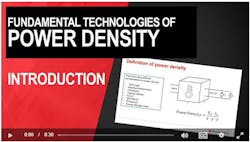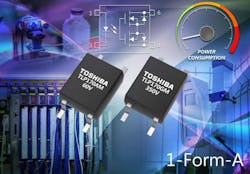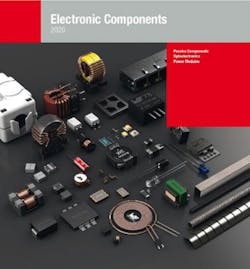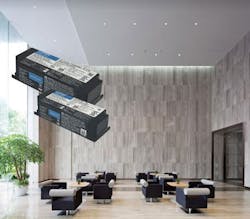This Week in PowerBites: Defining Power Density, Smart LED Drivers
>> Electronic Design Resources
.. >> Library: Article Series
.. .. >> Article Series: PowerBites
Customizable Reference Designs Speed Development of e-Bikes, Robots, Energy-Storage Systems, and More
Renesas Electronics has introduced an integrated ecosystem of customizable reference designs intended to accelerate the development of 12- to 48-V mobility, utility, and energy-storage applications. The evaluation boards, and accompanying reference designs, which include an e-scooter, e-bike, and a UPS, share a common platform of modular hardware and software functional blocks. These can be adopted for many other 24- to 48-V applications, such as lawn mowers, electric carts, robot cleaners, power tools, power banks, etc. This modular approach lets customers select different functional blocks for a wide range of applications while reducing time to market, BOM cost, and other resources.
The development ecosystem is based on 15 Renesas ICs, including three key devices: the ISL94216 16-cell battery front end (BFE), robust HIP2211 100-V MOSFET drivers, and RX23T 32-bit MCU with an integrated floating-point unit (FPU) to support complex inverter control algorithms.
The ecosystem also makes extensive use of the ISL78264 dual synchronous buck controller and the ISL78263 dual synchronous boost and buck controller. Both devices simplify power-supply design by integrating FET drivers that can deliver 96% peak efficiency and >10-A output current. The reference designs for 48-V mobility applications are all based on a 25-Ah Li-ion battery that powers a 1600-W inverter capable of driving a motor up to 5000 rpm.
A full description of the 48-V mobility solution, including block diagrams, component datasheets, and links to sample or order components for the reference design can be accessed by clicking here.
Mass-production quantities of the ISL78264 dual sync buck controller and ISL78263 dual sync boost and buck controller are available now in 5- × 5-mm, 32-lead, wettable flank QFN packages.
Additional information on the devices is available at the following links:
- ISL78264 and evaluation board (click here)
- ISL78263 and evaluation board (click here)
Up Your Power Game: White Paper, Video Tutorials on Designing High-Density Power Supplies
To better understand the fundamental technologies of high-power-density designs, Texas Instruments is offering the white paper "Understanding the Trade-offs and Technologies to Increase Power Density" and a related five-part training video series. Both resources provide insights on four important aspects of high-power-density solutions:
- Reduced loss generation.
- Optimal topology and control selection.
- Effective heat removal.
- Reducing system volume through mechanical and electrical component integration.
To get things rolling, the paper's author Jeffrey Morroni, Ph.D., a Manager at TI's Kilby Center, explains that the traditional definition of power density of a product, e.g., a converter, is its output divided by the volume it occupies is incomplete and can be misleading. Among other things, the design's relevant power capability may be affected by a combination of ambient temperature, maximum acceptable case temperature, orientation, altitude, and expected lifetime. Morroni also points out that, there’s no standard method for defining the volume of the power supply, leaving it subject to interpretation, based on its application and construction.
After introducing a more useful way to define power density, the paper explores the factors that limit it, including the issues surrounding switching losses and thermal performance, as well as design strategies for overcoming them. The 12-page white paper is complemented by the video series "The Fundamental Technologies of Power Density,” which provides practical examples of the design techniques used to achieve high power density in a variety of power-conversion applications.
You can download the whitepaper by clicking here and watch the video series by clicking here.
Photorelays Offer Low Trigger Current, Increased Sensitivity for Battery-Powered Apps
Toshiba Electronics Europe introduced two new photorelays—the TLP170AM and TLP170GM—targeting security systems, building automation, and other industrial equipment. Both devices are housed in a small 4-pin SO6 package and feature a low, 1-mA trigger LED current that reduces input-side power loss by increasing the sensitivity of the photodiode array. In battery-powered security devices and sensing applications requiring ON/OFF control, designers can use these photorelays to minimize power consumption and increase operating life. The TLP170AM has a rated off-state output terminal voltage (Voff) of 60 V. It features a typical on-state resistance (Ron) of 0.15 Ω and constant on-state current (Ion) of 0.7 A, with pulse operation of up to 2.1 A. The TLP170GM is a 350-V version with a typical Ron of 28 Ω, and Ion of 110-mA constant current and 330-mA pulse operation.
Both devices have a rated operating temperature between −40 and 85°C to allow for a temperature margin in system-level thermal design. The 4-pin SO6 package enables a minimum isolation voltage of 3750 V rms, allowing the devices to be used in equipment requiring high insulation performance.
Paper or Pixels? Do Your Component Shopping the Old-Fashioned Way
Although it's not nearly as thick as the 20th century's legendary Sears and Roebuck catalogs, the arrival of Würth Elektronik's “Electronic Components 2020” catalog may evoke similar feelings of excitement for power engineers. Available in print or .pdf, the 184-page document includes a greatly expanded selection of power-related devices, passive components, and power modules.
Among the new items of interest to those involved with power-related designs are the new high-current flat-wire inductors (WE-HCM), multilayer ceramic inductors (WE-MK), and WE-CST EE4.4 series current-sense transformers. According to Würth, the unique architecture of these transformers makes them smaller and better insulated than comparable magnetic products. The catalog also offers an expanded selection of the MagI³C-FDSM family of high-efficiency power modules.
Würth Elektronik takes pride in ensuring that all products listed in the new catalogue are available from stock. They also offer free-of-charge samples to support developers in their projects in connection with the design kits, which can be refilled at no extra charge. You can order your print catalog or download the .pdf edition from their customer service page by clicking here.
Smart, Efficient LED Drivers for Downlights
Lutron's Hi-lume EcoSystem Drivers bring high efficiency and intelligence to LED downlights used in smart-building applications, such as Nora Lighting’s small aperture 2” and 4” Iolite LED Downlights. The specified drivers include Soft-on and Fade-to-Black features that allow for smooth, flicker-free dimming from 100% down to 1% or 0.1%. The light source fades smoothly between 0% and 1% when turned on and off for an incandescent-like effect.
Lutron drivers can be linked to the Lutron Quantum Total Light Management system to monitor lighting power consumption. In addition, the drivers can be integrated into a planned or existing EcoSystem or Vive lighting-control solution for guaranteed dimming performance, and a non-volatile memory restores all settings after a power failure.
>> Electronic Design Resources
.. >> Library: Article Series
.. .. >> Article Series: PowerBites






